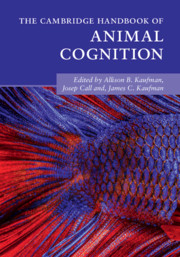Book contents
- The Cambridge Handbook of Animal Cognition
- The Cambridge Handbook of Animal Cognition
- Copyright page
- Dedication
- Contents
- Figures, Tables, and Boxes
- Contributors
- Acknowledgments
- Introduction
- Part I Communication and Language
- Part II Memory and Recall
- Part III Social Cognition
- Part IV Social Learning and Teaching
- 19 Social Learning and Teaching Overview
- 20 Tandem Running Recruitment by Temnothorax Ants as a Model System for Social Learning
- 21 Fish Social Networks
- 22 Social Learning in Birds
- 23 Social Learning in Chimpanzees
- Part V Numerical and Quantitative Abilities
- Part VI Innovation and Problem-Solving
- Index
- References
20 - Tandem Running Recruitment by Temnothorax Ants as a Model System for Social Learning
from Part IV - Social Learning and Teaching
Published online by Cambridge University Press: 01 July 2021
- The Cambridge Handbook of Animal Cognition
- The Cambridge Handbook of Animal Cognition
- Copyright page
- Dedication
- Contents
- Figures, Tables, and Boxes
- Contributors
- Acknowledgments
- Introduction
- Part I Communication and Language
- Part II Memory and Recall
- Part III Social Cognition
- Part IV Social Learning and Teaching
- 19 Social Learning and Teaching Overview
- 20 Tandem Running Recruitment by Temnothorax Ants as a Model System for Social Learning
- 21 Fish Social Networks
- 22 Social Learning in Birds
- 23 Social Learning in Chimpanzees
- Part V Numerical and Quantitative Abilities
- Part VI Innovation and Problem-Solving
- Index
- References
Summary
Collective intelligence – superior performance by groups compared to that of the individuals that compose them – is often achieved via social information use. However, collective intelligence has rarely been studied in terms of social learning. This is partially because social learning strategies (i.e. "when" and "who" to copy) are often hard to observe in a natural group setting. Our main goal in this article is to show that tandem-running recruitment by Temnothorax ants offers a promising model to study the interaction of social learning and collective intelligence. We first review the role of tandem runs in the ecology and collective behavior of these ants, who use them to share information about the locations of valuable resources. A key advantage of Temnothorax ants as a model system is that each instance of information sharing – each tandem run – can be easily observed. Moreover, the specific information transferred can be readily inferred by tracking the history and subsequent behavior of leader and follower. We then propose new investigations into how social learning via tandem runs affects their collective performance. Finally, we discuss how the synthesis of the two fields of social learning and collective intelligence can shed light on the role of feedback from learning in improving collective performance over time.
Keywords
- Type
- Chapter
- Information
- The Cambridge Handbook of Animal Cognition , pp. 472 - 485Publisher: Cambridge University PressPrint publication year: 2021
References
- 1
- Cited by



